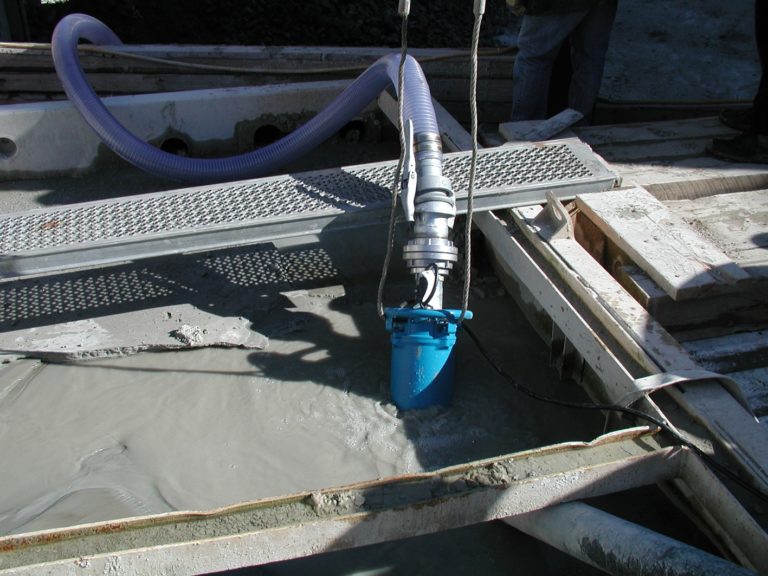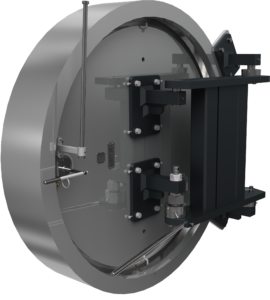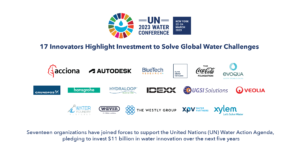Tsurumi: Water pumps in concrete applications

Characteristic for water pumps in concrete environments: Cooling jacket - free housing, powerful agitator, robust construction. Picture shows the KRS2-80 from Tsurumi (Image source: Tsurumi (Europe) GmbH)
The processing of finished concrete elements usually involves the use of clear or process water to cool drilling and sawing machines. If no tap line is available for this purpose, improvisation is key: A barrel with a pump is already enough. The manufacturer Tsurumi has developed a “miniature” pump for this scenario, the Family-12, which is as small as a football. Nevertheless, it has a lot to offer with only 100 watts of motor power, it manages 80 l/min, pumps up to two floors and does not even mind granular dirt (up to 6 mm diameter). This residue dewatering pump empties a water barrel completely, stopping only at a residual level of one millimetre. Since only moist whiff remains, the 3,400 gram pump even replaces the need for final drying with a cloth for example.
Those who need more should consider the larger model LSC: also a residue dewatering pump, but providing 170 l/min and 11 m maximum delivery height. The more powerful model is also the basic equipment of many fire brigades: The technology has proven its worth, and there is no backflow of water even when the pump is lifted.
Concrete recycling water
Concrete recycling takes on a different dimension. This involves residual water contaminated with cement or concrete residues. These waters may contain grain sizes in the micrometer range but may also include crumbly lumps of concrete up to 30 mm in size. The larger pieces are sieved out in a water bath. The remaining residual water containing cement grains and other fine materials is used to rinse out truck mixers or is returned to the production process. Dewatering pumps with "concrete suitability" take over these tasks.
At Tsurumi, there are three series: the KTZ, KRS and UZ, which are all well suited for “hard” recycling water. Among them is the frequently selected KRS2-80 for up to 100 m3/h flow capacity and almost 16 m maximum delivery head. The KRS2 series is particularly characterised by its powerful agitators at the intake opening to make media with a high solid content more fluid.
A common design aspect is the absence of the cooling jacket. This is a characteristic feature of “concrete ready” pumps and is used to dissipate heat from the motor. Cooling jackets would wear quickly from the inside due to the abrasive particles in the pumped medium. Instead, the heat dissipation takes place via the large dimensioned housing of the submerged pump, which dissipates the heat to the surrounding medium. Nevertheless: Pumps with cooling jackets (such as the NKZ series from the above manufacturer) are also sometimes used - the specific task defines the model selection.
Safety precautions in the pump
The core task of the designs is therefore to prevent rapid wear and tear of the internal components. The Japanese keep the abrasive medium away from the neuralgic components. On the design side, they rely among other things on a double internal mechanical seal without water contact. In addition, a shaft sleeve with sealing ring and several sealing lips protects the shaft from the abrasive particles in the water flow. The fact that many components such as the impeller, wear plate and not least the housing are made of hardened materials such as silicon carbide in the shaft seal helps to extend the service life. A specially developed oil lifter lubricates the pump in every position, so that users can even face the thermally sensitive slurping or dry running with confidence.
If more than the usual 30 mm maximum solid handling diameter is required, special pumps such as the UZ series can be used. Their work with up to 100 mm, allowing even thick lumps to pass through the unit without damage. Thanks to its particularly low speed, this slow moving pump is also more resistant than its fast counterparts (at a comparable flow capacity).
Pumps have to meet a similar requirement profile in civil engineering applications such as the setting of diaphragm walls when binder suspensions containing cement and betonite are used, as well as generally in water logistics for formwork, geothermal energy and other demanding tasks.
Source: Tsurumi (Europe) GmbH







